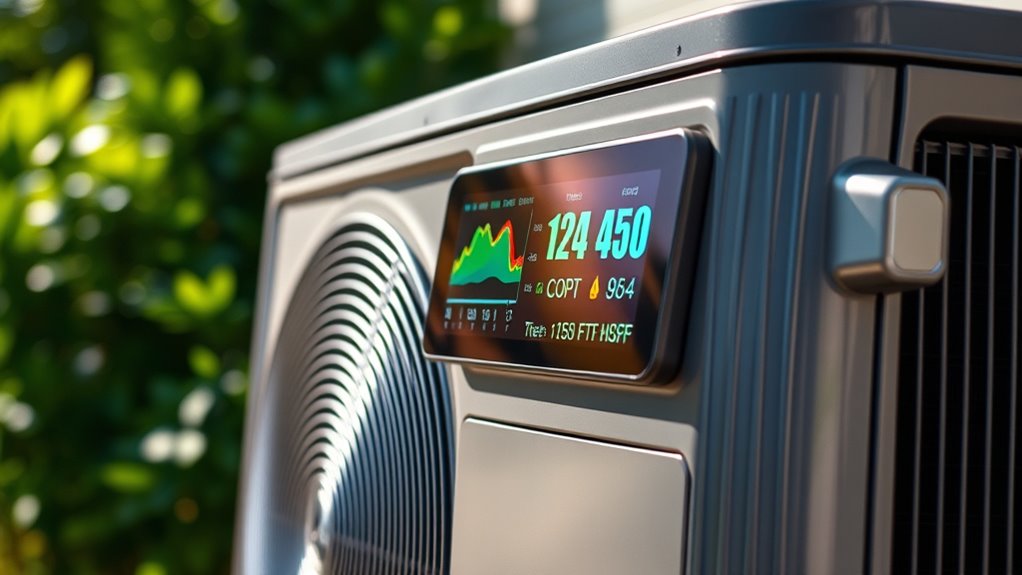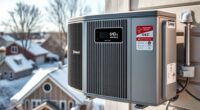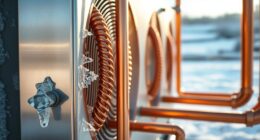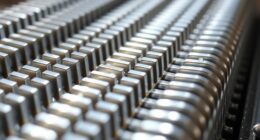COP and HSPF ratings show how efficiently your heat pump works. COP measures how much heat it moves compared to energy used, while HSPF indicates seasonal heating performance. Higher numbers mean better energy savings and lower bills. Factors like climate, installation, and system design influence these ratings. To get the most out of your system, it’s important to understand these metrics. Keep exploring to discover how to maximize your heat pump’s performance.
Key Takeaways
- COP measures heat pump efficiency by comparing heat output to electrical input at specific conditions.
- HSPF indicates seasonal heating performance by dividing total heating BTUs by total electrical energy used annually.
- Higher COP and HSPF values signify better efficiency and lower energy costs over time.
- External factors like outdoor temperature and system design influence both COP and HSPF ratings.
- These ratings are determined through standardized testing, helping compare models and ensure regulatory compliance.
What Are COP and HSPF and Why Do They Matter?
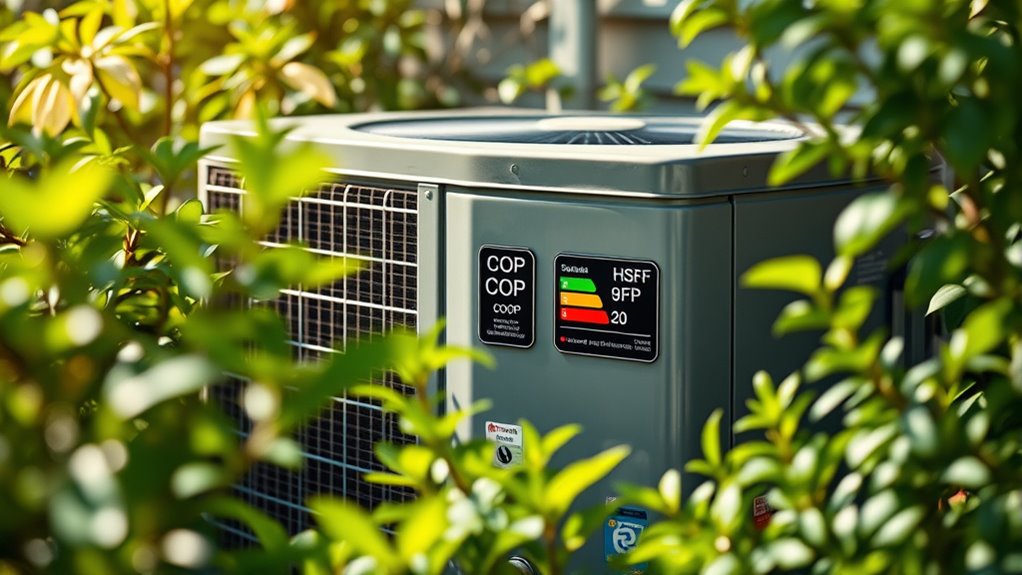
Have you ever wondered how energy-efficient your heat pump really is? COP, or Coefficient of Performance, measures this efficiency by comparing the heat it delivers to the energy it uses. HSPF, or Heating Seasonal Performance Factor, evaluates how well your heat pump performs over an entire heating season. Both ratings are crucial because they help you understand how much energy you save and how environmentally friendly your heating system is. Higher COP and HSPF values mean better efficiency, which can lower your utility bills and reduce your carbon footprint. These metrics also help you compare different models and ensure you meet regulatory standards. COP and HSPF ratings are calculated based on standardized testing procedures, which makes them reliable indicators of real-world performance. Understanding these ratings empowers you to choose a heat pump that’s cost-effective and eco-friendly, ensuring your investment pays off long-term.
How Are COP and HSPF Calculated?
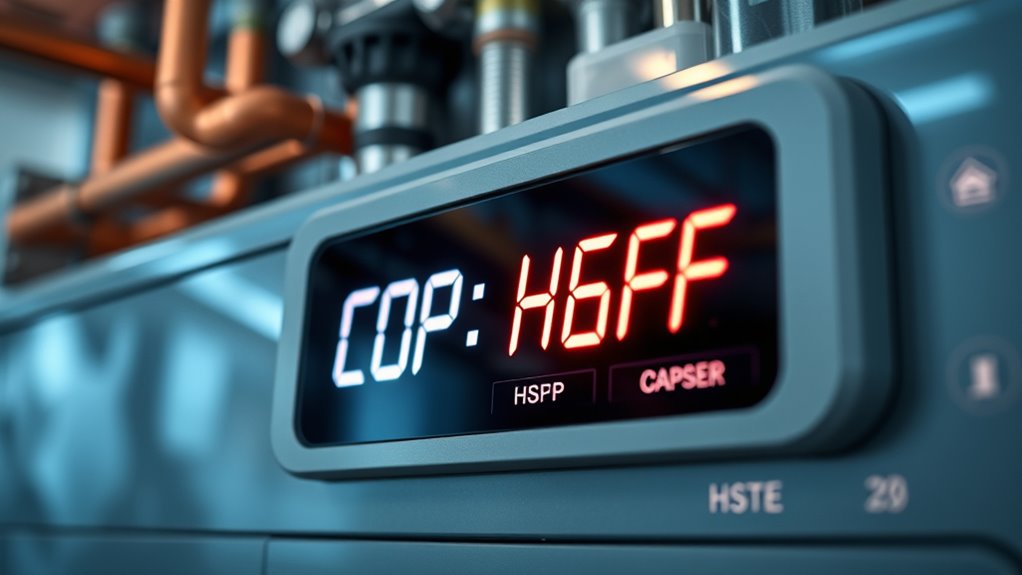
Understanding how COP and HSPF are calculated is key to evaluating your heat pump’s efficiency. COP is determined by dividing the heat output (BTUs or watts) by the electrical energy input (kWh or watts). It’s a simple ratio that varies with temperature, usually higher at lower temperature differences. For example, if your heat pump produces 10,000 BTUs of heat and consumes 1 kWh, the COP is 10. HSPF, on the other hand, measures seasonal heating efficiency. It’s calculated by dividing total heating BTUs delivered over a season by total electrical energy consumed in kWh. For instance, a heat pump delivering 120 million BTUs while using 15,000 kWh has an HSPF of 8. Both metrics help you assess performance, but they focus on different timeframes and conditions. The calculation of HSPF involves summing the heat delivered over the entire heating season and dividing it by the total energy used, which accounts for varying outdoor temperatures and usage patterns. Seasonal variations and local climate conditions can significantly impact these ratings, making it important to consider climate factors. Additionally, understanding energy consumption patterns can assist in optimizing your system for maximum efficiency across seasons. Furthermore, advances in performance tuning can help improve heat pump efficiency by adjusting operational parameters based on environmental conditions.
The Advantages of High Efficiency Ratings
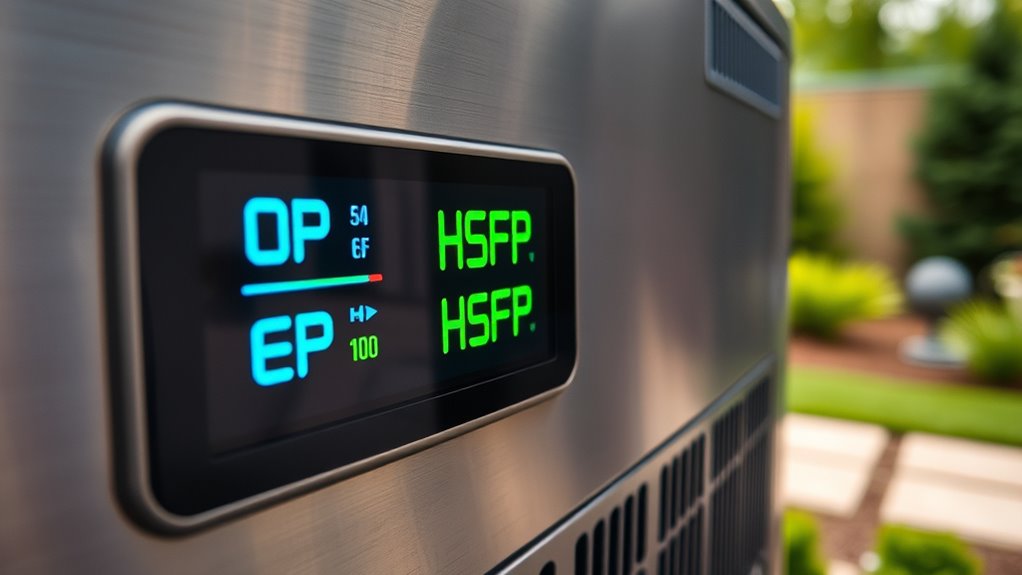
High efficiency ratings in heat pumps offer significant benefits by reducing energy consumption and lowering your utility bills. With higher HSPF2 and SEER2 ratings, your system uses less energy to heat or cool your home, saving you money over time. These efficient systems perform well even in extreme temperatures, maintaining consistent comfort without extra energy costs. They also require less maintenance and operate more quietly, enhancing your indoor environment. Environmentally, high-efficiency heat pumps produce fewer greenhouse gases and reduce reliance on fossil fuels, supporting sustainability. Additionally, airless paint sprayers can make home improvement projects more efficient, complementing the energy savings achieved with a high-efficiency system. Incorporating energy-efficient appliances can further enhance overall home performance. The integration of advanced technology in modern heat pumps is driving further improvements in efficiency and user experience. Regular upgrades to system components ensure that these benefits are maintained over the lifespan of the heat pump. Long-term, the cost savings from reduced energy bills can offset higher upfront investments, making these systems a smart choice. Plus, they often qualify for rebates or incentives, further improving their cost-effectiveness in the long run.
Factors That Affect Heat Pump Performance Ratings
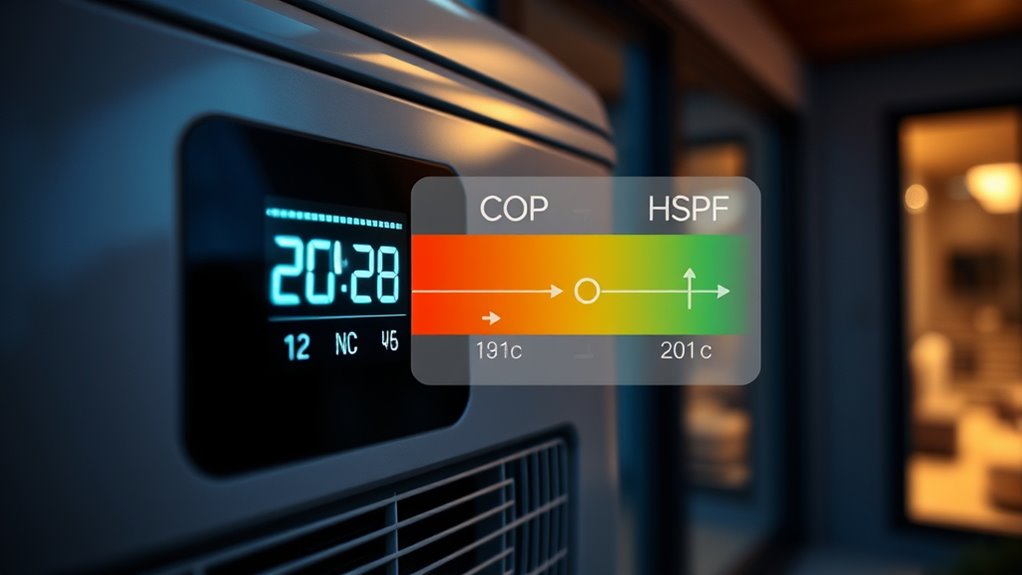
Several key factors influence heat pump performance ratings, shaping how efficiently your system operates in real-world conditions. Climate and environment play a big role: extreme outdoor temperatures reduce efficiency, especially for air-source units, while geothermal systems stay stable. High winds or debris near outdoor units disrupt airflow, lowering heat exchange. Humidity affects cooling demand, and snow or ice buildup increases energy use through defrost cycles. System design matters too: higher SEER and HSPF ratings indicate better efficiency, and variable-speed compressors adapt to demand. Proper installation and maintenance are essential—incorrect refrigerant charges, dirty filters, or poor placement can decrease performance. Additionally, beneficial maintenance practices help sustain optimal operation over time. Regularly inspecting and cleaning air filters ensures unobstructed airflow and improved system efficiency. Home factors like insulation, air leaks, and zoning influence how hard your heat pump needs to work, impacting its efficiency ratings. Efficient system operation depends heavily on consistent maintenance and prompt repairs when issues arise. Environmental conditions such as air quality can also impact the longevity and performance of your heat pump components.
Strategies to Improve COP and HSPF Ratings
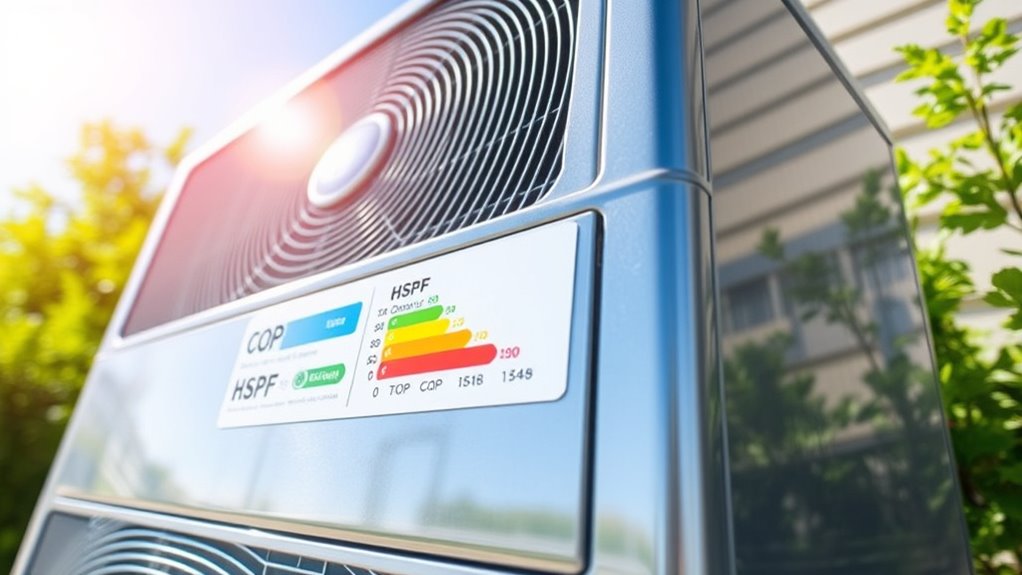
Enhancing COP and HSPF ratings involves targeted design improvements, component upgrades, and climate-specific adjustments. You can boost efficiency by incorporating inverter-driven compressors that adjust speed based on demand, reducing energy waste. Upgrading heat exchangers with improved coil designs enhances heat transfer, improving performance across climates. Implementing smart defrost mechanisms minimizes energy loss during frosting conditions. Better insulation within the unit reduces heat loss, maintaining efficiency. Multi-stage systems offer precise temperature control, saving energy. Upgrading components like high-efficiency fans and modern sensors helps optimize operation. Using environmentally friendly refrigerants increases heat transfer effectiveness. In cold climates, features tailored for low temperatures improve performance, while zone control systems reduce unnecessary energy use. Efficiency ratings like COP and HSPF provide a benchmark for evaluating improvements, guiding homeowners and technicians to prioritize upgrades that deliver the most significant performance gains. Understanding the heat transfer process can further aid in making informed enhancements. Additionally, incorporating advanced control systems allows for better adjustment and optimization of the heat pump’s operation. Recognizing the impact of component quality and its role in overall efficiency is essential for achieving higher ratings. Investing in regular maintenance can also help sustain peak performance over time. These strategies collectively elevate your heat pump’s COP and HSPF ratings.
Comparing COP and HSPF With Other Efficiency Metrics
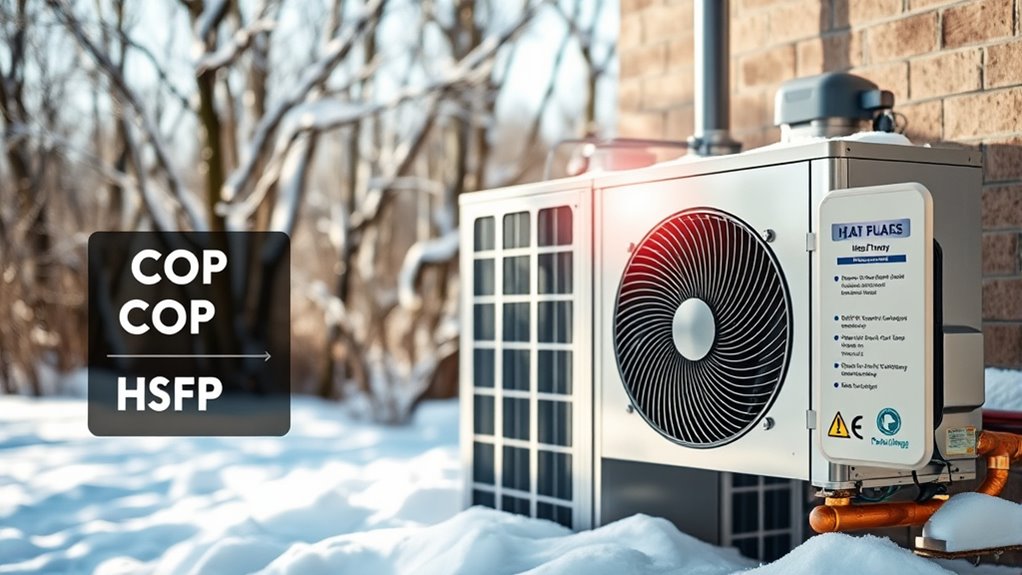
When comparing heat pump efficiency metrics, understanding how COP, HSPF, and SEER relate helps you make informed decisions. COP measures a heat pump’s efficiency at specific conditions, indicating how much useful energy transfer you get per unit of power used. HSPF evaluates seasonal heating performance, showing overall effectiveness during the heating season, and it considers variations in temperature and usage patterns. SEER, on the other hand, focuses on cooling efficiency over a season. While COP provides instant efficiency snapshots, HSPF and SEER assess performance across longer periods. Comparing these metrics helps you select a system suited to your climate and needs. Other regional metrics like EER and ESEER also exist, emphasizing the importance of understanding the context behind each rating for accurate evaluation. Using multiple metrics gives a thorough view of a heat pump’s efficiency, especially since measurement standards can vary between regions. Being aware of performance metrics helps ensure you choose a system that performs well year-round and in your specific environment. Additionally, understanding efficiency ratings can aid in optimizing your energy consumption and reducing operational costs.
The Role of Climate and Installation in Efficiency
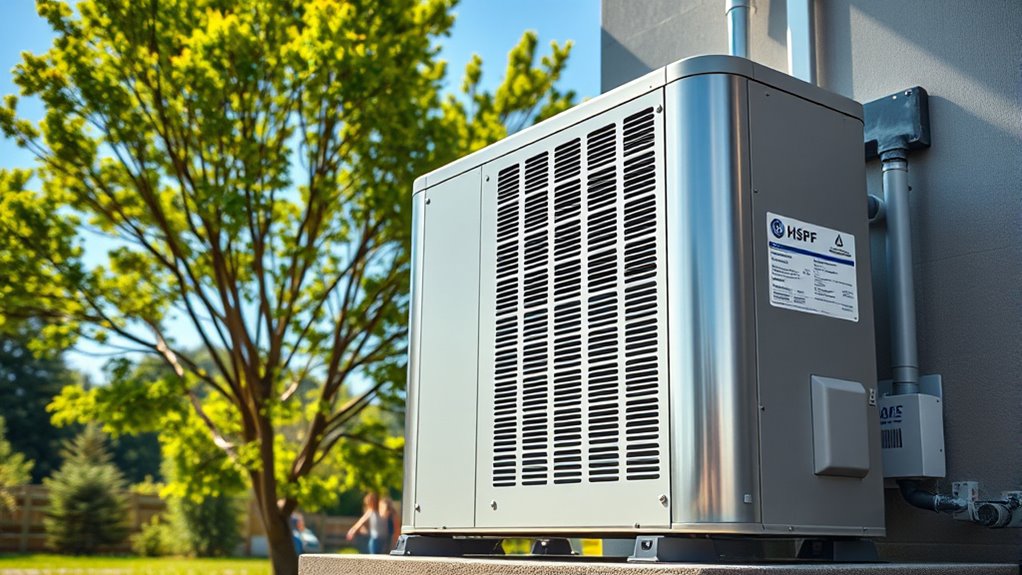
Climate and installation conditions play a pivotal role in determining a heat pump’s efficiency. In colder climates, efficiency drops as outdoor temperatures fall, reducing the COP and making the system less effective. However, ground-source or geothermal heat pumps often maintain higher efficiencies in cold weather, with COPs reaching up to 5. Conversely, in mild climates, heat pumps perform ideally, delivering better efficiency due to ample ambient heat. Proper installation is equally critical; it ensures the system operates at peak performance, minimizing energy waste. Poor installation or site-specific miscalculations can notably decrease efficiency, regardless of climate. Additionally, integrating the heat pump correctly with your building’s thermal characteristics and existing systems helps maximize performance and reduce energy consumption, regardless of regional challenges. Efficient system design and maintenance can further enhance performance and longevity, ensuring that the heat pump delivers optimal savings over its lifespan. Moreover, understanding climate-specific factors such as thermal load and humidity can help tailor the system for maximum efficiency. Ensuring proper refrigerant management is also essential, as it impacts both efficiency and environmental impact. Regular monitoring and performance testing can identify potential issues early, maintaining optimal operation. Incorporating advanced control systems can optimize operation based on real-time conditions, further improving efficiency. Properly selecting and installing auxiliary heating systems can also help maintain comfort and efficiency during extreme weather conditions.
Regulatory Standards and Certification Requirements
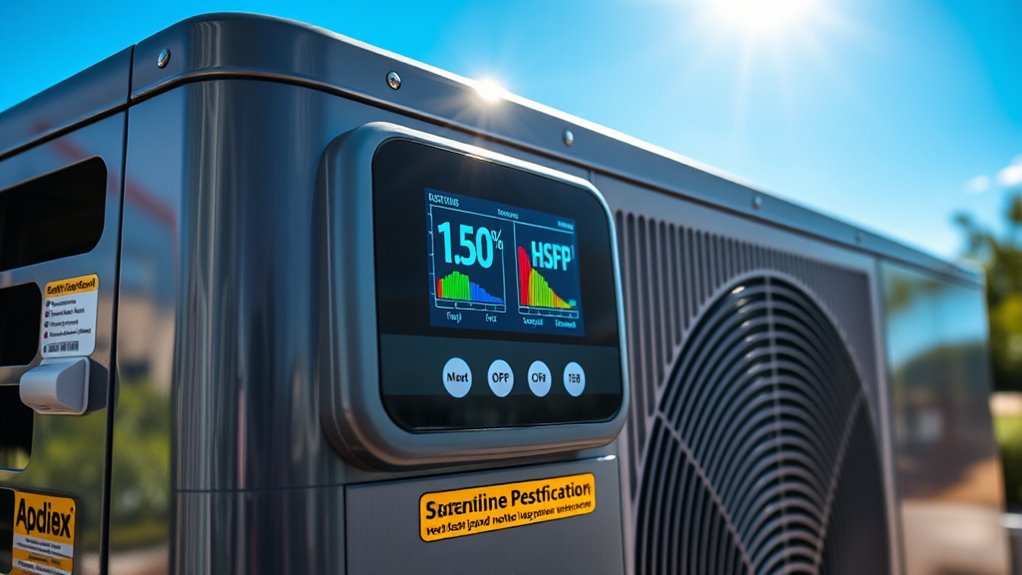
Regulatory standards and certification requirements play a crucial role in guaranteeing that heat pumps meet specific performance and safety benchmarks. The U.S. Department of Energy sets federal energy efficiency standards that manufacturers must follow, influencing product design and testing. Voluntary programs like AHRI certification verify that heat pumps meet rigorous performance criteria. These standards are regularly updated to incorporate technological advancements and market changes, requiring manufacturers to adapt. Compliance involves thorough testing, documentation, and adherence to protocols such as Appendix M for heat pumps. International organizations like IRENA also promote standards that improve predictability and performance globally. For you, understanding these requirements helps ensure that the heat pump you choose is reliable, efficient, and safe, meeting both industry standards and your expectations. Understanding the specific test procedures and documentation required is essential for proper compliance.
Choosing a Heat Pump Based on Efficiency Ratings
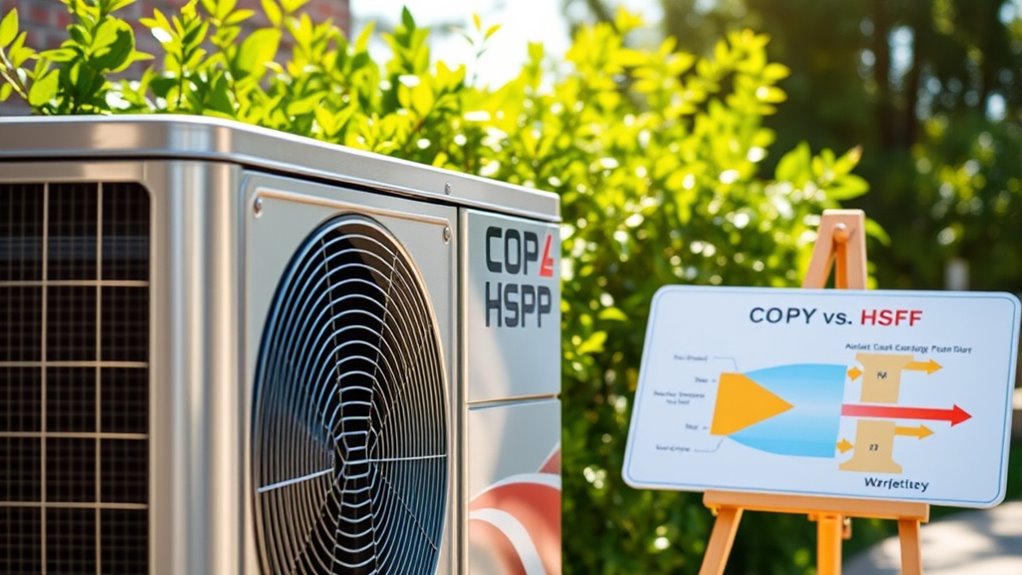
Choosing a heat pump based on efficiency ratings is essential for maximizing energy savings and comfort. Focus on HSPF ratings for heating efficiency, especially in colder climates, where higher ratings (up to 13.5) mean better performance during winter. In warmer areas, prioritize a high SEER rating (13 to 21) for cooling efficiency. Remember, higher ratings typically lead to lower energy costs and a smaller carbon footprint. While high-efficiency models cost more upfront, they often save money over time through reduced utility bills. Consider the climate, system type, and proper sizing to guarantee ideal performance. Evaluating these ratings helps you select a heat pump that balances initial investment with long-term savings and environmental benefits. Additionally, understanding AI security concerns can help ensure your smart home systems operate safely and reliably, maximizing the benefits of your energy-efficient investments. Staying informed about energy efficiency ratings can also aid in making better purchasing decisions that align with your sustainability goals. Furthermore, paying attention to performance metrics like HSPF and SEER ensures you choose a system optimized for your specific needs.
Frequently Asked Questions
How Do COP and HSPF Ratings Vary With Outdoor Temperatures?
You’ll notice that COP and HSPF ratings decrease as outdoor temperatures drop because heat pumps become less efficient in colder weather. When it’s warmer outside, your heat pump operates more effectively, boosting COP and HSPF values. Conversely, in colder conditions, these ratings decline, meaning your system uses more electricity for the same amount of heating. So, climate considerably impacts your heat pump’s efficiency throughout the seasons.
Can a Heat Pump’s Efficiency Ratings Decline Over Time?
Think of your heat pump as a well-tuned orchestra, but over time, its harmony can falter. Yes, efficiency ratings decline as components wear, coils get dirty, and airflow restrictions build up. These issues cause your system to work harder, much like a singer hitting sour notes. Regular maintenance, coil cleaning, and timely upgrades keep your heat pump performing at its peak, preventing efficiency from slipping away like a fading melody.
Are Higher COP and HSPF Ratings Always Better for Every Climate?
You wonder if higher COP and HSPF ratings are always better for every climate. The truth is, higher ratings generally mean more efficiency, saving you energy and money. But in colder climates, a high HSPF is especially important for effective heating. In warmer areas, cooling efficiency might matter more. So, consider your climate and heating or cooling needs to choose the ratings that best suit your environment.
How Do Maintenance Practices Influence Actual COP and HSPF Performance?
Ever wonder how your maintenance habits can turn the tide on your heat pump’s efficiency? You play a crucial role in this story. Regularly changing filters, checking coils, and repairing refrigerant leaks keep your system running smoothly. These practices prevent strain on components, reduce cycling, and maintain essential heat transfer. When you prioritize maintenance, you guarantee your heat pump delivers better COP and HSPF performance in real-world conditions, saving energy and money.
Do Different Brands Have Comparable COP and HSPF Ratings?
You might wonder if different brands offer similar COP and HSPF ratings. Generally, they do, thanks to industry standards and technological advances. However, ratings can vary based on system design, climate, and model specifics. To guarantee you’re choosing an efficient heat pump, compare ratings carefully, look for certifications, and consider how regional conditions impact performance. Higher ratings usually mean better efficiency, regardless of the brand.
Conclusion
Understanding COP and HSPF can seem complex, but their importance is clear—they reveal how efficiently your heat pump performs. As you consider these ratings, remember that climate and installation can influence results more than you’d expect. Will higher ratings truly save you money? The key lies in deciphering these metrics—so stay informed, ask questions, and choose wisely. Your perfect, efficient heat pump might be closer than you think—if you know what to look for.
